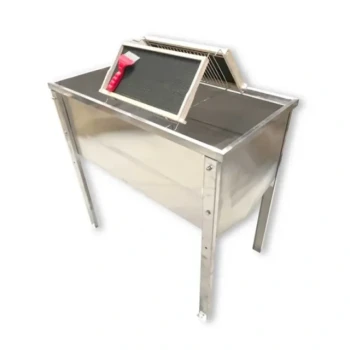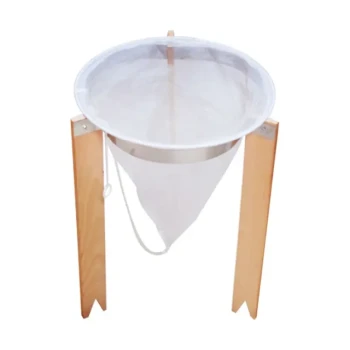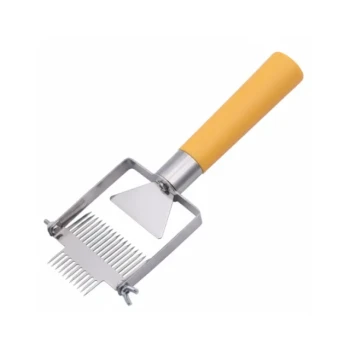In short, mixing tanks for honey processing are widely available in sizes ranging from 100 gallons to over 5,000 gallons. This range is designed to support everyone from small-scale artisanal producers to large, industrial-level operations, ensuring a solution exists for nearly any production volume.
The critical decision is not about the available sizes, but about correctly matching a tank's capacity to your specific batch size, operational workflow, and future growth ambitions.

Matching Tank Size to Operational Scale
Choosing the right tank is a foundational decision for your operation's efficiency. The size you need is directly tied to the volume of honey you process in a single batch.
Small-Scale and Hobbyist Operations (100 - 300 Gallons)
Tanks in this range are ideal for producers just starting out, testing new products, or running an artisanal or hobbyist-level business. They offer a lower initial investment and require less physical space.
This size is perfect for managing smaller, more specialized batches of honey without committing to the footprint and cost of a larger industrial unit.
Mid-Sized Commercial Producers (500 - 2,000 Gallons)
This is the most common range for established, growing honey businesses. It represents the sweet spot for balancing batch volume with operational flexibility.
A tank in this category allows for significant production runs, enabling a business to meet growing market demand efficiently before needing to scale to a much larger, industrial facility.
Large-Scale Industrial Processing (2,500 - 5,000+ Gallons)
Tanks of this magnitude are built for high-volume, continuous processing. They are the standard for major honey producers and packers who handle massive quantities daily.
These systems are designed for maximum throughput and are often integrated into a larger, more complex production line that may include pasteurizers, liquefiers, and automated bottling equipment.
Understanding the Trade-offs
Selecting a tank isn't just about meeting today's needs; it's about avoiding future bottlenecks or inefficiencies. Both oversizing and undersizing come with significant downsides.
The Cost of Oversizing
Purchasing a tank that is far too large for your current production leads to wasted capital and operational inefficiency. You pay more upfront and use more energy to heat or cool a partially filled tank.
The Constraint of Undersizing
A tank that is too small becomes a production bottleneck very quickly. It limits your ability to scale, forces you to run multiple inefficient batches, and can ultimately stifle your business's growth.
How to Choose the Right Tank
Your choice should be a strategic one based on a clear understanding of your goals.
- If your primary focus is launching a new artisanal brand: Start with a smaller tank (100-300 gallons) to minimize initial costs while you establish your process and market.
- If your primary focus is scaling an existing, profitable operation: Select a tank (500-2,000 gallons) that can handle at least 1.5x your current average batch size to accommodate growth.
- If your primary focus is maximizing industrial throughput: Invest in the largest tank (2,500-5,000+ gallons) that your facility and budget can support to ensure you meet high-volume demands.
Ultimately, the right tank provides the capacity you need today with the flexibility you'll require tomorrow.
Summary Table:
| Operational Scale | Typical Tank Size Range | Ideal For |
|---|---|---|
| Small-Scale & Hobbyist | 100 - 300 Gallons | New producers, artisanal brands, testing products |
| Mid-Sized Commercial | 500 - 2,000 Gallons | Established, growing honey businesses |
| Large-Scale Industrial | 2,500 - 5,000+ Gallons | High-volume producers and packers |
Ready to optimize your honey processing workflow?
Choosing the right mixing tank is critical for efficiency and growth. At HONESTBEE, we supply commercial apiaries and beekeeping equipment distributors with the durable, high-performance tanks they need to scale their operations.
Let our experts help you select the perfect tank size to meet your current batch volume and future ambitions. Contact HONESTBEE today for a consultation and wholesale pricing on industry-leading beekeeping supplies.
Visual Guide

Related Products
- Professional Honey Storage Tank with Agitation System
- Stainless Steel Honey Storage and Settling Tank with Double Strainer
- Stainless Steel Heated Honey Tank Warming Heating Tank
- Stainless Steel Uncapping Tank with Stand and Strainer
- Professional Honey Filter with Tripod Support Stand
People Also Ask
- How long does it take to settle honey? Achieve Perfect Clarity in 2-4 Days
- Where are stainless steel screw honey pumps commonly used? In Commercial Honey Processing & Quality-Focused Operations
- How long to leave honey to settle before bottling? Achieve Perfect Clarity in 48 Hours
- What should be done with the condensate in the recovery tank during the concentration process? Ensure Peak System Efficiency
- What type of tank is used in the honey drying process? Master Gentle Moisture Removal for Premium Honey



















